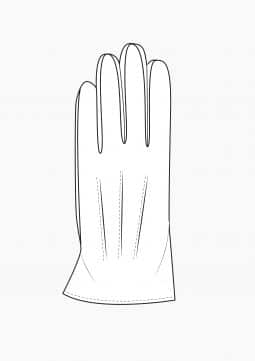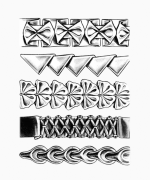Sewing Button
Deutsch
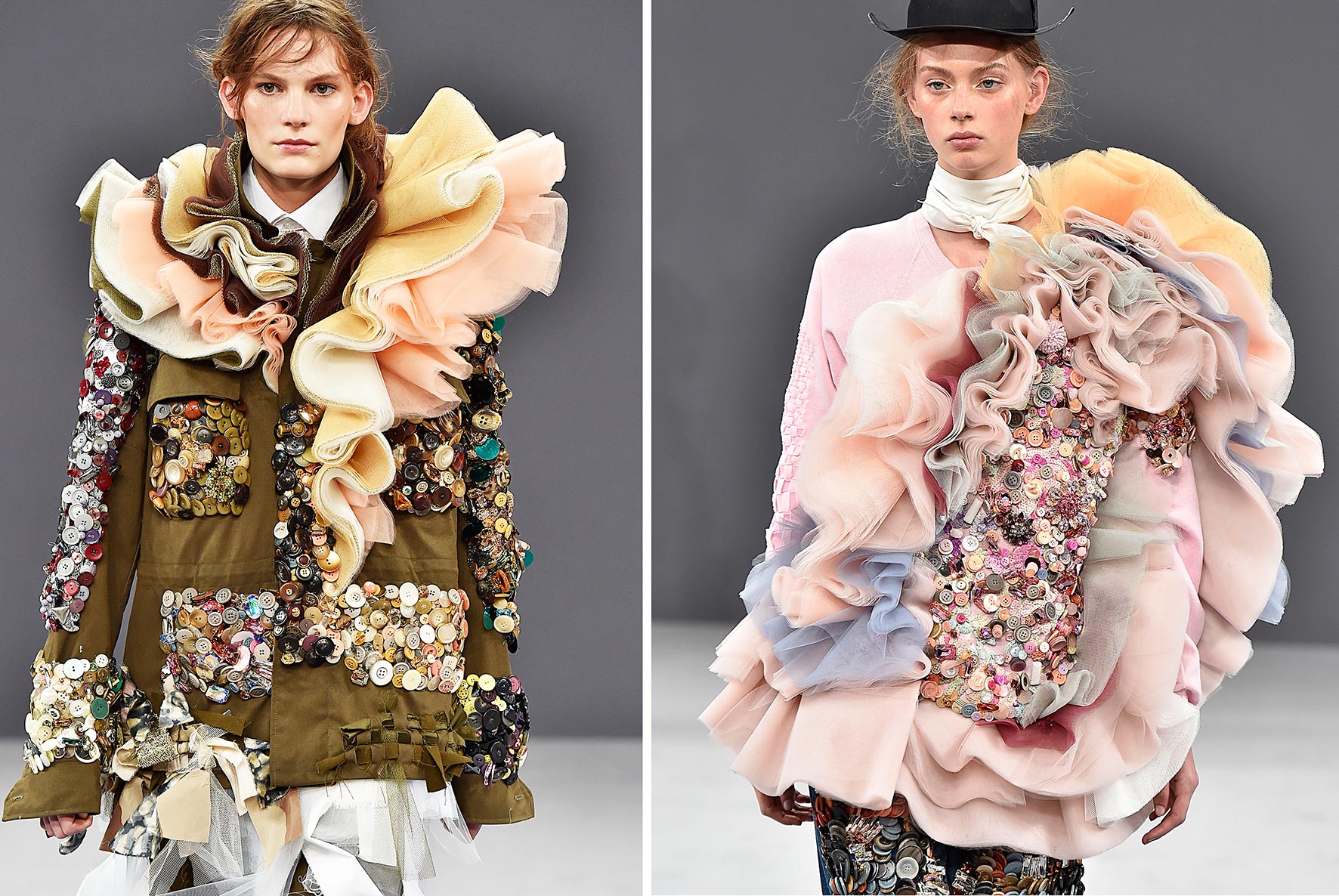
Content
The History of the Button
The button – an inconspicuous, sometimes hidden detail, was displaced by zipper and push button over the last couple of years, recently becomes a trendy accessory. The sky is the limit when it comes to imagination, as long as it is big and striking the design. And yet, it does not matter whether it satisfies the original needs – to function as a closure for garments. The history of the button goes back to the Stone Age. Buttons were made out of bone, wood and stone and originally should probably potect from spell or boost fertility and strength. In ancient times, buttons served as jewelry, in Asia loops and noose where twined around them. The crusaders brought the buttons to Europe and in the 13th century the buttonhole was invented in Germany. This changed the fashion fundamentally, because from now on was possible to wear tight-fitting clothing. Sleeves and pants were buttoned onto the jerkin and at a tournament, many of noble ladies threw one of their unbottoned sleeves to the victorieous knight as a sign of recognition. The button becomes the status symbol the wealthy, he is manufactured by from gold and silver by goldsmiths, set with diamonds and decorated with precious stones. From the 18th century, fantastic creations are preserved, however, buttons where a privilege of men – women were laced up in their the bodices and using hooks as additional closures. It was not until the beginning of the Industrialization in the 19th century and new manufacturing techniques allowed the production of large numbers, the button was now also affordable for the lower social class. easier layers. Buttons made from mother of pearl are only known for about 100 years.

Button knowledge – in a nutshell
The profession of a button maker was very much respected up to 1950s. In a Baden-Württemberg button makers regulation from 1719 is even reported that an apprenticeship for the handicraft takes six-years. The heyday of the craft was in the 17. and 18th century. King Ludwig XIV. sat new standards when he ordered special buttons for his State robe: The so-called “Bouttonnier”, made of diamonds. Katharina the Great also loved buttons for decorating purposes of her robes; and so the button manufactureres in all European Countries experienced their highest upswing during that time. Famous artists and porcelain manufacturers created buttons – to mimic shine and glamor for the common folk, the semi-precious stones and rhino diamonds were often replaced by glass and enamel. Although there was a prohibition on exporting the knowledge about buttons and although button makers were not allowed to emigrate, the button know-how somehow arrived in America. With the Industrial Revolution the mass production of buttons began, especially for uniforms. In Paris, the fashion houses discovered buttons for women’s clothing towards the end of the 19th century. At the beginning of the 20th century silver buttons with glass were popular, and in the 20s / 30s were materials such as wood and Bakelite were moving into the button world. Later (from the 1950s on) nylon, bast, cork and leather were added. And with the increasing of the environmental awareness from the 1980s on, natural materials returned – horn, leather, wood and the stone nut from Ecuador were in fashion. . Button stories were written by Coco Chanel with her big gold buttons on the skirt suit, and Dior with his simple four-hole model, the so-called Diorknopf, which became the epitome the haute couture.

Button ABC
Superstition
Sewing buttons sewn on in cross shape, drives off the devil. In the Erzgebirge, finding a shirt or pants button brings goodluck. Lucky is also who at the sight of a chimney sweep touches a button and repeats 3 times >>Bonjour ramoneur<<.
Anxiety
Hard to believe, but ten to twelve percent of the people, mostly women, suffer from “koopounophobia”. They are disgusted by buttons, some even avoid pronouncing the word “button”.
Styles
The disc, eyelet, hole, print, riveting, posamenterie, twisted and toggle button and the stud button for a chefs uniform, the push-through button for bed linen, the cuff links and the tailcoat button.
Etiquette
The style rule, which supposedly goes back to the obviously corpulent English King Edward VII (1841-1910), states: A gentleman always wears the bottom button of his vest unbuttoned. Also on a single breasted jacket with two buttons, the lower one always stays opens.
Your money or your life
In the old days, wealthy men wore silver buttons on their frock. In a robbery not only jewelry and money was stolen, but mostly the buttons of the clothes were cut off. “To unbutton something from someone / to get something out of someone” means taking away money or valuables. “Let the last button jump” means spending the last penny. “Button or Peak … whatever you want” is a threat. “Attached by only one button left” it is only a question of a trifle.
Materials
Bamboo, raffia bast, precious stones, ivory, glass, wood, horn, bone, coconut, coral, plastic, leather, gold, silver, tin, copper and iron, Mother of pearl, stone, stone nut, cloth, clay.Right or left? Today it is common to find the buttons attached to the men’s clothing on the right side, and on women’s on the left. There are several theories, one of them says that the gentlemen were left to themselfes when it came to buttoning up their clothes, while the ladies had to be dressed by a maid.Collectors Especially the historical uniform buttons are high in demand for purchase or as trade objects. Also wanted are buttons of known artists and designers like Elsa Schiaparelli, Alberto Giacometti, Coco Chanel, Yves Saint Laurent, Jacques Fath, Jean-Paul Gaultier and many more.

Sewing on a Button
This tutorial and other manufacturing techniques can be found in the textbook Atelier – Fachwissen aus der Praxis Teil 2.
Even sewing a button wants to be learned. It is unprofessional, if the placket pulls or bulges, after a short amount of stress the button detaches itself from the garment.
The initial question is: Which is the right thread for sewing on buttons? In former times there were linen threads in many colors, which were very durable, but have not been produced for years. Replacement was the SERALON Size 30. This material is extremely durable and more supple than a linen thread. Other products are used as well. Climbing ropes today are no longer made of hemp or sisal after all, they are made of high-tech fibers. First you make a so-called “button setter”/”button twist”, an extra strong thread that is very durable. To avoid entanglement and knotting, the thread has to be over-twisted. To do this, thread a needle (e. g. Lamerts half-length nr 3) with the button thread.
- Separate the two ends and place them on the knee or an ironing cushion (tailor’s press mitt). To over twist, continue twisting the thread in the original direction. Once you let go the needle, the two threads intertwine. Repeat this process in sections of 20 cm to the end. Pull the button thread through preferably bees wax. To allow the wax to penetrate deeper into the thread, pull the waxed thread over the hot iron plate. You will see, it is well worth the effort.


- Now the sewing can begin, however, essential to know is the function of the button. A decorative button for a particularly beautiful line – as in double-breasted jackets or tails coats – a neck or shank is not needed, for the button should lay flat on the fabric. However, if a button is used to close two front pieces, the distance from the button to the fabric depends on the thickness of the material and has to be large enough so the button does not pull too much on the overlay.This corresponds to about 2-3 mm for regular fabrics. For sports jacket, costume, vest and trousers, two stitches through each buttonhole are sufficient. Buttons on these garments are in use and buttoned up quite often over the course of time. To add durability and to prevent wear and tear, the so-called neck or shank is wrapped a couple of times, the thread then sutured.
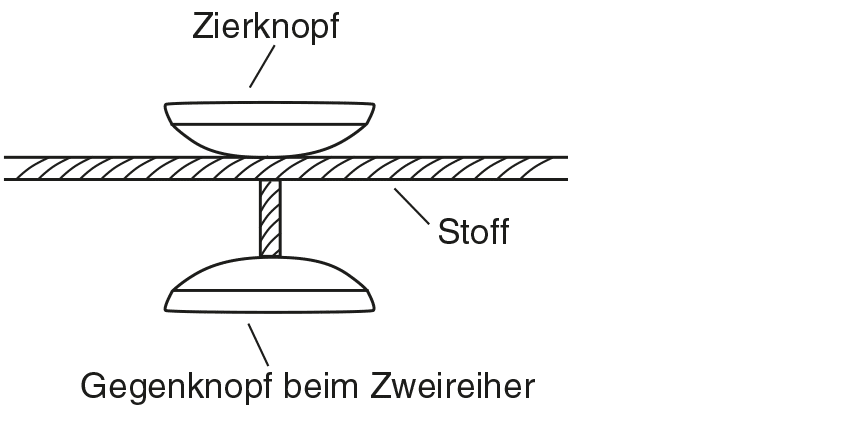
- For double-breasted coats, the neck or shank of the reinforcing button should be at least 1-1.5 cm long to allow some room for the underlay. On the other hand it should not be too long for the underlay may not be visible at the hem of the overlay. For the coat, three stitches through each buttonhole are sufficient, as more weight rests on the button. Depending on the thickness of the fabric, a thread shank of 4-5 mm in length is recommended.
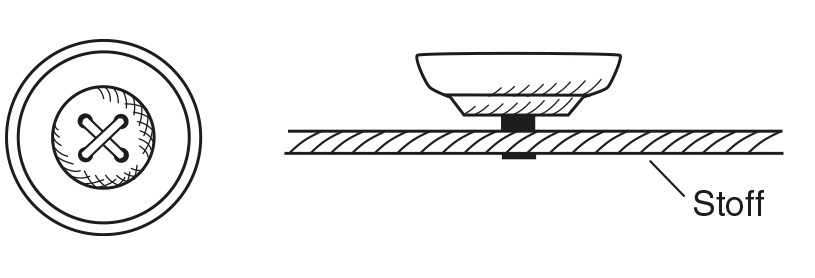
- Some gentlemen’s tailors are sewing on buttons crossed, the English way. You need to know that the Savile Row usually uses different buttons: the British buttons are shaped like little bowls. The button is sewn on crossed, resulting in an increase at the crossing point, which would wear off quickly when using buttons of flat shapes.

- Depending on personal preference, the buttons are sewn on with the visible threads being vertical or horizontal, yet parallel to each other.

- There are also buttons available in bowl shape for sporty pants, where it is common practice to be sewn on with crossed thread. However, most trouser buttons are extremely flat to not to stand out on thin fabrics. These are particularly milled so they only can be sewn on parallel.
Basic rules for button closures on blouses and dresses
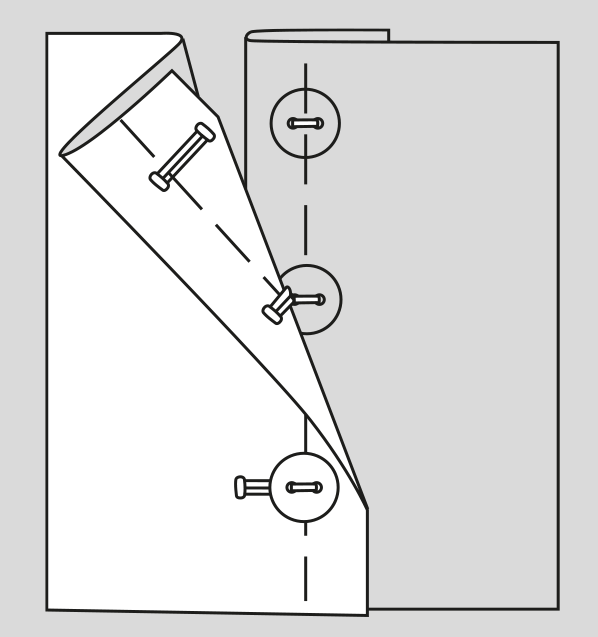
- Button and buttonhole close two overlapping fabric edges. On the upper edge of the fabric, the overlay, the buttonhole is worked. The button is placed on the lower edge of the fabric, the underlay.
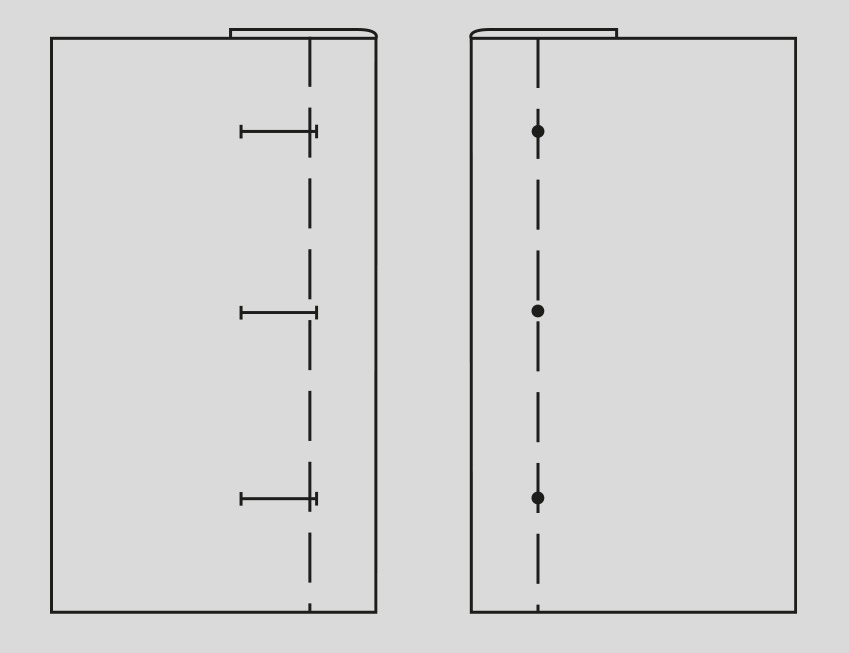
- Before marking the position of button and buttonhole, mark the centerline of the over- and under-lay. The buttonhole extends the center line by 2 mm, the button is placed exactly on the center line, the button placement line.
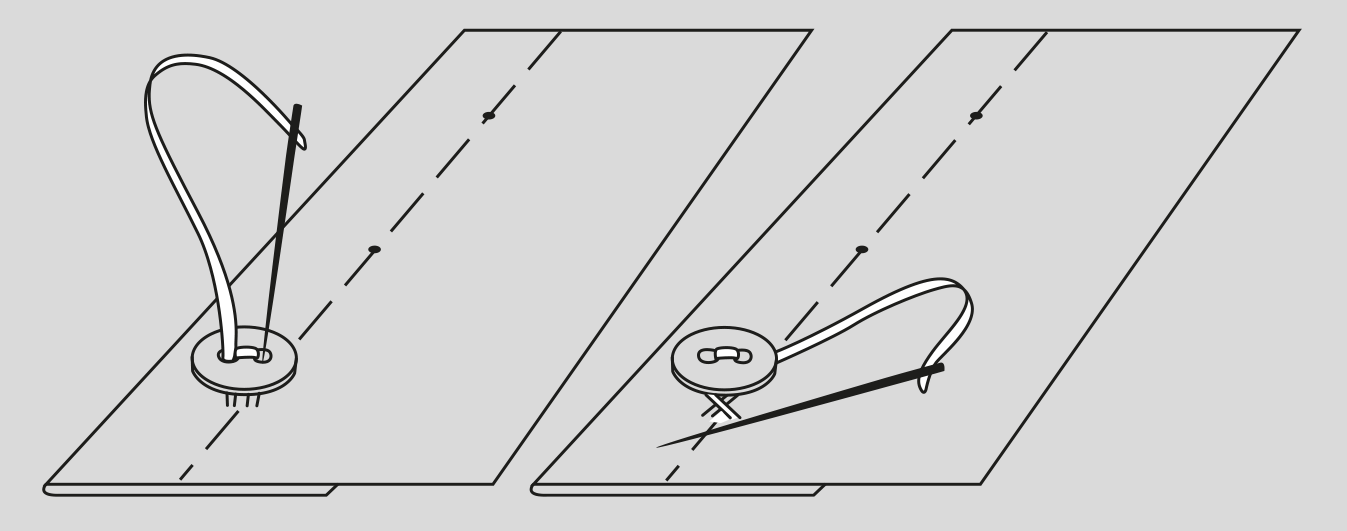
- The buttonhole placket closes smooth and free of wrinkles if there is enough space underneath the button to allow the overlay to move freely. Therefore, all buttons are sewn with a “shank”. Sew on the button with double thread. Tighten the sewing thread just enough to be able to create the buttons thread shank. Wrap the shank tightly with the sewing thread.
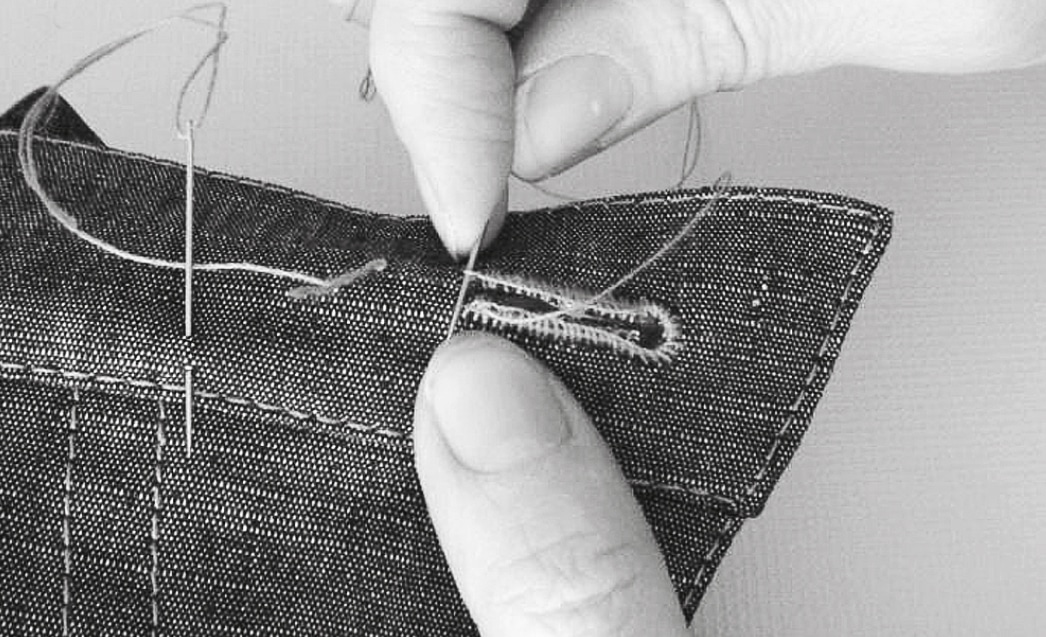
Further instructions and tips for sewing buttons and holes can be found here:


